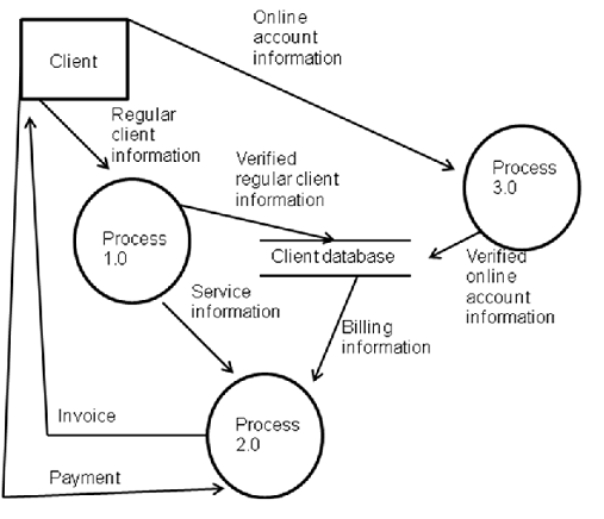Refer to the Level Zero data flow diagram below and the CWM case in responding to the next question: Comprehensive Waste Management (CWM) provides trash hauling services for several communities in southern California. When a new client wants to establish service, the client calls the company's main office on the phone. A CWM employee collects the following information from the client: name, street address, city, state, ZIP code, area code, telephone number, e-mail address. The employee gives the new client information regarding regular weekly service dates, special services provided by the company, fees and billing procedures. CWM bills its clients every two months in advance of the service; for example, bills are sent to clients at the beginning of January for the months of January and February. Initially, CWM does all its billing manually; they send out paper bills and collect payment from clients via check. Once service is established, a client can create an online account; the online account provides an option for paperless billing and a separate option for charging a credit card rather than paying with a mailed check. To create an online account, the client creates login credentials (user name and password) ; they provide their CWM account number (provided on the invoice) and relevant credit card data (type of card, name, billing address, and security code) . CWM's database uses the account number to look up the client's original information, then merges the new information with it.  Based on the Level Zero data flow diagram, which of the following statements about the context diagram is most true?
Based on the Level Zero data flow diagram, which of the following statements about the context diagram is most true?
Definitions:
Synthesized
Created or formed by combining simpler substances or elements through a chemical process, leading to a new compound or product.
Cash Dividend
A distribution of a portion of a company's earnings, decided by the board of directors, paid to a class of its shareholders.
Assets
Economic resources owned or controlled by a company; they have measurable value and are expected to benefit the company by producing cash inflows or reducing cash outflows in the future.
Stock Price Appreciation
The rise in the value of a company's shares over time, reflecting the market's increased valuation of the company.
Q1: The concept of bookkeeping includes: (i) distinguishing
Q7: Please refer to the following short case
Q9: On January 1, 2012, Hawkeye Corporation issued
Q19: When organizations use XBRL, they can free
Q19: CoBIT can be used to strengthen internal
Q35: Consider the following list as you respond
Q38: Refer to the financial information presented for
Q46: Based on a REA model, an accountant
Q63: An ASP specializes in software applications for
Q85: Fisher Apartments purchased an apartment building to